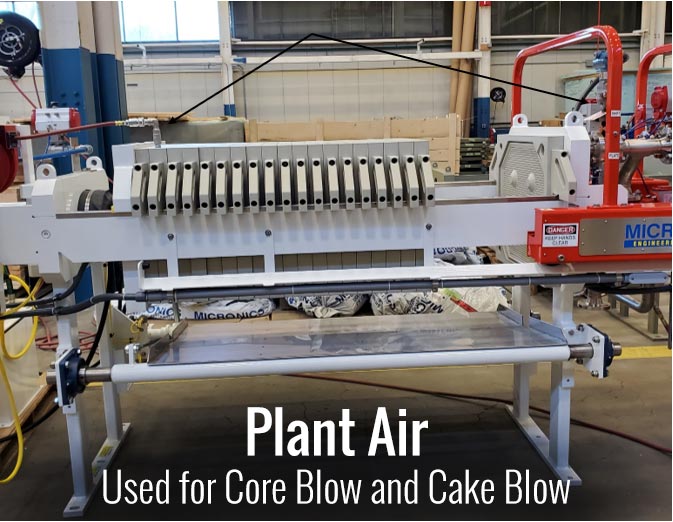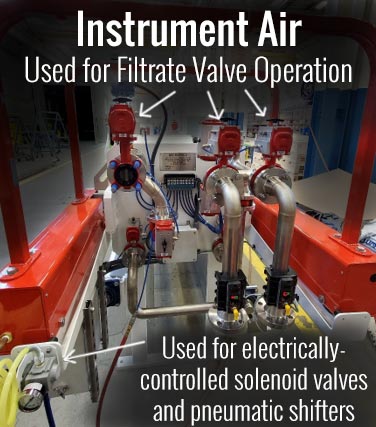This month we discuss the importance of your air supply in your filter press operation. When asked just how important the air supply is to a filter press operation, the answer was clear.
February Maintenance Tip of the Month: Ensure the Quality of Your Filter Press’ Air Supply for Optimal Press and Component Performance
Home > February Maintenance Tip of the Month: Ensure the Quality of Your Filter Press’ Air Supply for Optimal Press and Component Performance
When it comes to your wastewater treatment equipment such as the filter press, the quality of your air supply is a very important parameter, not to be overlooked. Ensuring the correct type of air to different areas of the filter press can eliminate unforeseen maintenance requirements.
There are essentially two types of air used in filter press operations, “Plant Air” and “Instrument Air.”
What is Plant Air?
“Plant Air” (also known as “Service Air”) is basically for machines that require air in large volumes but where it does not typically need to be extremely clean or dry.
When speaking about filter presses, Plant Air is used for Cake Blow and Core Blow functions.
What Is Instrument Air?
The term “Instrument Air,” on the other hand, refers to an extremely clean, dry supply of compressed air that is free from contaminants such as particulates and moisture. A system may utilize Instrument Air for various types of pneumatic equipment, valves, and electrically-controlled, air-actuated solenoids. Instrument Air utilizes high-efficiency filtration, eliminating potential issues with suspended liquids, such as compressor oil and particulates.
What Is Needed for My Filter Press Operation?
Although not all filter presses require both Plant Air and Instrument Air, as a rule of thumb, filter presses with pneumatic-actuated valves should be supplied with Instrument Air. As noted, Instrument Air is free of suspended liquids and particulates, ensuring the proper functioning of equipment, valves, and controls, and possibly preventing failure of these press components.
Plant Air Usage
Filter presses with a Cake Blow and/or a Core Blow step – used in many instances for further reducing cake moisture – may typically utilize “Plant Air” for these functions.

Cake Blow is not intended to fully dry your filter cakes. A Cake Blow function uses compressed air, and sometimes other gases, to remove residual moisture from filter cakes, filter plates, and filtrate piping. The compressed air is being supplied directly to the filter plates and filter cakes, normally through the upper filtrate piping, and then discharged through the lower diagonal filtrate piping. There are no intricate components that require Instrument-quality air. The volume and pressure of air for Cake Blow is dependent on the size of the filter press; Micronics will advise the client on the appropriate air volume (cfm) and air pressure (psi) based on the press size.
Core Blow is used to evacuate the feed necks throughout the plate stack. The core is the last bit of slurry that is pumped into the press. In some cases, the core is extremely dry, making it difficult to clean the dried cake from the feed holes in the plates. Other times the core does not fully dry; in these instances, it is difficult or impossible to evacuate the final slurry left in the core. Compressed air is used to blow this core out of the plate stack and normally return the wet slurry to the slurry feed tank. Again, as with air for Cake Blow, the air volume and pressure are determined by the filter press size.
Instrument Air Usage

Many of Micronics’ customers use a point of source compressor and an air-line drying system for their Filter Press “Instrument Air” needs.
We do recommend that an air-line drying system be installed, particularly if high levels of moisture are present in your compressed air supply. The use of the drying system helps to eliminate moisture and particulates from being picked up in the line between the receiving tank and filter press. Long lines, temperature changes, broken lines for maintenance, and even local weather conditions can contribute to good air turning to bad air prior to entry into the Filter Press.
Something as simple as your air supply can have an important effect on your filter press operation including potentially influencing cycle time.
Contact Micronics for onsite field service, for filter press replacement parts, replacement filter cloth, and assistance with optimizing your liquid-solid separation process. Every detail makes the difference in optimizing your filter press operation.
Categories
Featured Posts
- Micronics Announces
Strategic Acquisition of
SOLAFT® Filtration Solutions - Chennai Office Inauguration
- Micronics Engineered Filtration Group Announces Strategic Acquisition of AFT®, Dry Filtration Solutions Leader, from FLSmidth
- The Power of Teamwork
- Building a High-Performance Team: Key Factors for Success
- Micronics’ CEO, Chris Cummins, Is Featured On “Manufacturing Excellence” Podcast
- Micronics Announces Large, Multi-plant Filter Press Order for Lithium-Ion Battery Recycling for EVs
- Micronics Engineered Filtration Group Announces Strategic Acquisition of Trusted Filtration Industry Leader, National Filter Media (“NFM”)
Contact Our Experts
Micronics Is Your Trusted Partner for Total Engineered Filtration Solutions. We offer end-to-end solutions from Filter Media to Industry-Leading Filtration Equipment, to Spare Parts & Accessories, to On-Site Field Services and In-House Laboratory Services. Whether for your Filter Press, Belt Press, Leaf Filter, Vacuum Filter, or Baghouse, you can count on Micronics’ deep industry and applications knowledge for the right engineered filtration solution to meet your needs. We look forward to working with your team.
